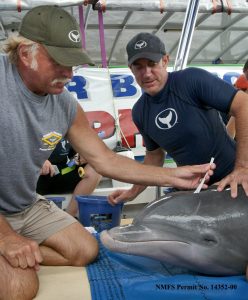The old saying goes: “Don’t judge a book by its cover.” Well, the same could be said about bottlenose dolphins.

Bottlenose dolphins are the most common and well-known of their kind – famous in TV and movies. And while one bottlenose dolphin might look similar to another, when you take a closer look at them (really close, as in genetically,) there are differences. In fact, a recently published study in the Journal of Heredity (Vol. 104, pp 765-778) focused on groups of these animals that live in specific areas along the eastern seaboard of the United States, comparing them to other bottlenose dolphins that live offshore, in the northwest Atlantic Ocean, Gulf of Mexico and the Caribbean.
This first-of-its-kind collaborative study revealed that within the Indian River Lagoon (IRL), there are two different, distinct populations of bottlenose dolphins living in the waters. After the data were analyzed, researchers were able to determine that these two, genetically different groups were divided along a north-south geographic area of the IRL. Along with identifying genetic differences in the animals within the IRL, when compared to bottlenose dolphins that live in other areas, including the open oceanic waters, additional differences were found.
While there were many findings identified, this study also provides important management implications since it’s clear the role of the habitat, and subsequent modifications, can directly shape bottlenose dolphin structure.

